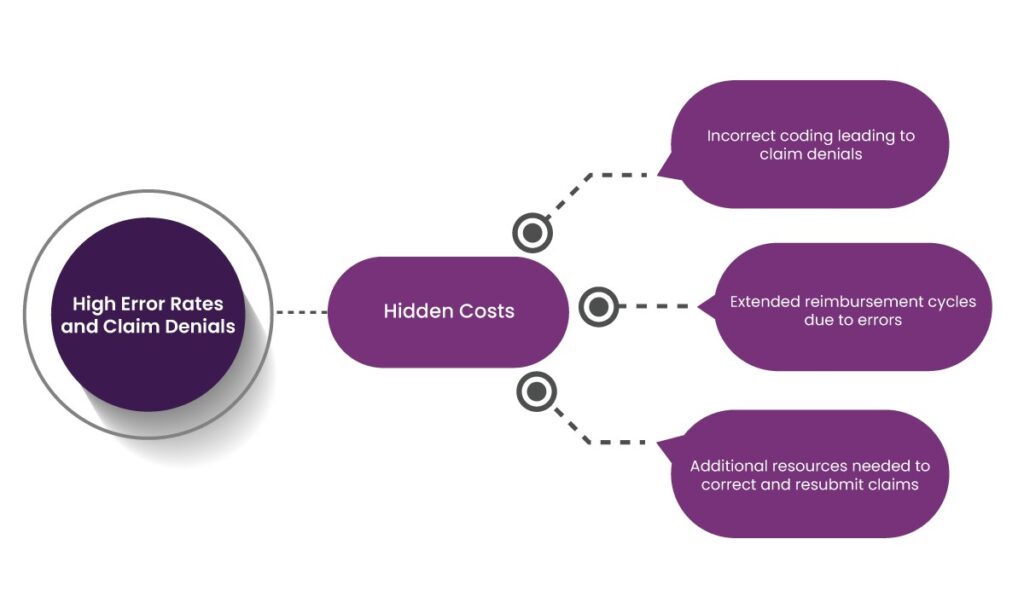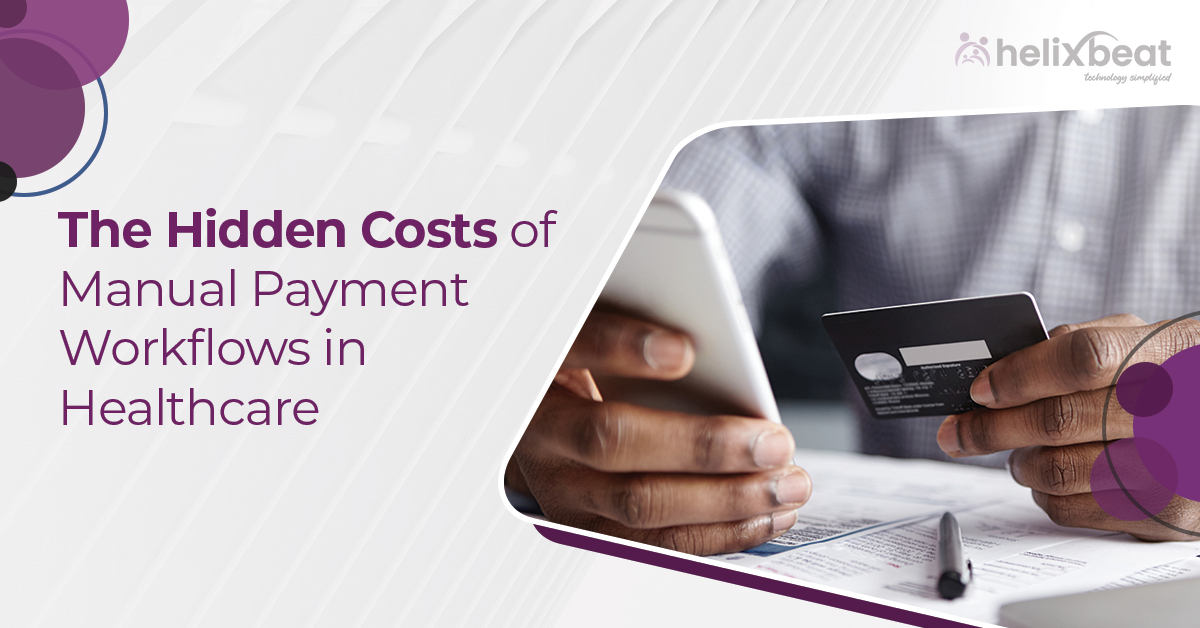Table of Contents
Introduction
Let’s be honest—managing payments in healthcare can feel like a never-ending battle. Between mountains of paperwork, insurance claim rejections, and chasing overdue bills, your team spends more time fixing payment issues than actually caring for patients. And the worst part? The financial toll is bigger than you might think.
Every manual payment process comes with hidden costs—staff hours lost to data entry, revenue delays due to billing errors, and even compliance risks that could lead to hefty fines. A single typo on a claim can mean weeks of back-and-forth with insurers, while slow payment cycles can create serious cash flow problems for your practice. Patients, too, feel the frustration when they’re hit with unexpected bills or struggle to make payments easily.
So, what’s the solution? It’s time to step away from outdated systems and embrace automation. In this blog, we’ll uncover the real cost of manual payment workflows and show you how the right payment processing system can transform your practice—saving time, cutting costs, and improving patient satisfaction.
The True Costs of Manual Payment Workflows
1. Increased Administrative Costs
One of the most significant downsides of manual payment processing is the excessive administrative workload it places on healthcare staff. Billing teams often spend hours processing invoices, verifying insurance claims, and managing payment collections.
Hidden Costs:
- Labor-intensive data entry leading to high staffing costs
- Time-consuming reconciliation of payments and claims
- Inefficient communication between providers, payers, and patients
A report from the Council for Affordable Quality Healthcare (CAQH) found that automating healthcare transactions could save the industry over $13 billion annually. Without automation, staff members must spend a significant portion of their workday handling payment-related tasks that could be streamlined with digital solutions.
If a hospital processes 5,000 claims per month and each manual claim takes 15 minutes, that results in 1,250 staff hours per month. Assuming an average administrative staff wage of $20 per hour, the hospital spends $25,000 per month ($300,000 per year) on manual payment processing alone. Automating claims processing could reduce these costs by up to 70%, leading to an annual savings of $210,000.

2. High Error Rates and Claim Denials
Manual payment workflows are prone to human error, which can result in incorrect billing, missing information, and claim denials. A single typo or miscalculated amount can delay reimbursements, requiring time-consuming appeals and corrections.
Hidden Costs:
- Incorrect coding leading to claim denials
- Extended reimbursement cycles due to errors
- Additional resources needed to correct and resubmit claims
The American Medical Association estimates that billing errors occur in up to 25% of claims. If a hospital submits 10,000 claims per month, 2,500 claims could require rework. The cost of reprocessing each claim is approximately $25, leading to a monthly loss of $62,500 and an annual loss of $750,000.

3. Slow Payment Processing and Revenue Delays
Manual billing processes often result in slow payment cycles, causing cash flow disruptions for healthcare providers. Paper-based invoicing and check payments can take weeks to process, delaying reimbursements from insurers and payments from patients.
Hidden Costs:
- Delayed cash flow affecting financial stability
- Increased risk of unpaid bills and bad debt
- Time wasted tracking down outstanding payments
Healthcare organizations rely on timely payments to cover operational costs, staff salaries, and medical supplies. However, delays in reimbursement can lead to financial instability and difficulty in maintaining quality patient care.
If a clinic experiences a 30-day delay in receiving $500,000 in insurance reimbursements, and its operational costs amount to $400,000 per month, it may have to rely on credit lines or loans to cover expenses. With an interest rate of 6% per annum, the additional financial burden amounts to $2,500 per month ($30,000 per year) in interest payments alone.
4. Compliance Risks and Data Security Issues
Healthcare payments involve sensitive patient financial and medical data. Manual processes increase the risk of non-compliance with regulations such as HIPAA and PCI DSS. Storing paper records and processing payments manually can expose providers to data breaches and compliance violations.
Hidden Costs:
- Risk of fines and penalties due to non-compliance
- Increased vulnerability to data breaches
- Legal and reputational damage from security incidents
A data breach in the healthcare sector costs an average of $10.93 million per incident (IBM Security). If a hospital processes 50,000 transactions per year and a 0.5% breach rate leads to 250 compromised transactions, the financial impact can be substantial. Legal fees, compliance fines, and reputational damage could cost millions in settlements and lost business.
5. Poor Patient Experience and Lower Satisfaction Rates
A seamless billing and payment experience is crucial to patient satisfaction. Manual payment workflows often lead to confusion, billing disputes, and frustration for patients, particularly when they receive unexpected bills or struggle to navigate complex payment processes.
Hidden Costs:
- Higher call volumes and increased support costs due to billing inquiries
- Patient dissatisfaction leading to lower retention rates
- Damage to the provider’s reputation due to negative reviews
If 10% of patients experience billing issues and 50% of them decide to switch providers, a clinic seeing 20,000 patients per year could lose 1,000 patients annually. Assuming an average patient revenue of $500 per year, this results in a revenue loss of $500,000 per year.
Patients expect a smooth and transparent payment process, similar to what they experience in other industries. Providers that fail to meet these expectations may struggle with patient retention and loyalty.
The Impact of Hidden Costs on Your Practice
Decreased Profit Margins
Higher processing fees, lost sales opportunities, and chargebacks or fraudulent transactions are just some of the hidden costs associated with using manual payments. Hidden fees expand your operational budget, and the worst part is that providers are often unaware of all the manual payment processes. As a result, they end up paying more than they’d previously accounted for, significantly reducing their profits.
Damage to Reputation and Brand Image
Extended wait times and manual payment processing ruin patient and staff experience, causing them to lose confidence and trust in your health facility. Patients expect a seamless payment experience when paying for medical services. If your payment processing system is inefficient or prone to errors, it can lead to negative patient experiences and damage your reputation and brand image.
Inability to Invest in Growth Opportunities
Your ability to grow can certainly become limited if you are not using a high-quality payment processing system. When you’re constantly spending money on unnecessary fees or dealing with the fallout from having a system that frustrates your patients, you have less money to put towards expanding your practice, investing in new equipment, hiring additional staff, or marketing campaigns that could fuel business growth.
How to Choose the Right Payment Processing System for Your Practice?
Managing payments effectively is crucial for healthcare institutions, as inefficient financial processes can lead to administrative burdens, revenue delays, and compliance risks. A well-integrated payment processing system simplifies transactions, improves cash flow, enhances patient satisfaction, and ensures regulatory compliance. Paynova is a robust payment solution designed to address these challenges, offering seamless automation and security while optimizing financial operations.
Why Choose Paynova?
1. Seamless Payment Automation
Manual payment workflows are time-consuming and prone to errors, leading to claim denials and revenue losses. Paynova automates the entire payment process, reducing administrative workload and minimizing errors. With automated reconciliation, billing, and insurance verification, healthcare providers can focus on patient care instead of financial paperwork.
2. Multi-Payment Support
Patients expect flexibility when it comes to payment options. Paynova enables healthcare providers to accept various payment methods, including credit/debit cards, digital wallets (such as Apple Pay and Google Pay), and direct insurance payments. This versatility ensures a smoother payment experience for both patients and providers.
3. HIPAA & PCI DSS Compliance
Security and compliance are non-negotiable in healthcare transactions. Paynova is fully compliant with HIPAA and PCI DSS regulations, ensuring that all financial and patient data remains secure. With advanced encryption and fraud protection features, healthcare organizations can prevent data breaches and unauthorized transactions.
4. Real-Time Analytics
Financial insights are essential for managing cash flow and making data-driven decisions. Paynova provides real-time analytics, allowing healthcare providers to track payment trends, identify revenue gaps, and optimize financial performance through detailed reports and dashboards.
5. Patient-Centric Features
A positive patient experience is key to building trust and retention. Paynova enhances patient satisfaction with flexible payment plans, automated billing reminders, and secure transaction portals. Patients can easily manage their payments, reducing billing inquiries and improving overall satisfaction.
By integrating Paynova, healthcare providers can streamline financial operations, minimize costs, and enhance the overall efficiency of their practice.
Importance of Investing in the Right Payment Processing System for Your Practice
Managing payment processing can be a complex challenge for healthcare institutions of all sizes. With numerous patient transactions and financial operations to handle, it’s easy to feel overwhelmed. However, the right payment technology can simplify these processes, allowing your staff to focus on more critical tasks.
Upgrading your payment processing system is a strategic move that can enhance your practice’s efficiency. Paynova offers innovative solutions that streamline transactions, boost revenue, cut costs, and improve overall financial performance.
With a single, seamless process, you can optimize payments, reduce administrative burdens, and gain valuable insights into financial metrics.
Take advantage of these transformative solutions today—schedule a demo and experience the difference!
Customer also ask
1. What are the hidden costs of manual payment workflows in healthcare?
Manual payment workflows lead to excessive administrative costs, billing errors, delayed reimbursements, compliance risks, and poor patient experiences. These inefficiencies result in lost revenue, higher staffing expenses, and increased risks of claim denials and regulatory penalties.
2. How do manual payment processes increase administrative costs?
Healthcare staff spend countless hours processing invoices, verifying insurance claims, and handling payment collections. This labor-intensive approach raises operational expenses, slows down workflows, and diverts resources from patient care.
3. Why do manual payment workflows lead to high error rates and claim denials?
Human errors, such as incorrect coding and missing information, can result in claim rejections. Each rejected claim requires additional resources for corrections and resubmission, causing significant financial losses and delayed reimbursements.
4. How do slow payment processing and revenue delays affect healthcare providers?
Paper-based billing and manual payment methods lead to cash flow disruptions, making it difficult for providers to cover operational costs, pay staff, and invest in facility improvements. Delays in receiving reimbursements can force organizations to rely on costly credit lines.
5. What are the compliance risks associated with manual payment processing?
Manual processes increase the risk of non-compliance with HIPAA and PCI DSS regulations, potentially leading to hefty fines and data breaches. Storing paper records and handling payments manually expose healthcare organizations to security vulnerabilities.
6. How do manual payment workflows impact patient experience?
Patients often face confusion, billing disputes, and frustration when dealing with manual payment processes. Complicated or unexpected bills can lead to negative reviews, lower patient satisfaction, and reduced retention rates.
7. What are the benefits of automating payment workflows in healthcare?
Automation reduces administrative burdens, minimizes errors, accelerates reimbursements, enhances security, and improves the overall patient experience. It also ensures compliance with industry regulations and optimizes financial operations.
8. How can Paynova help healthcare providers streamline their payment processing?
Paynova offers seamless payment automation, supports multiple payment methods, ensures HIPAA & PCI DSS compliance, provides real-time analytics, and enhances patient experience with flexible payment plans and automated billing reminders.














